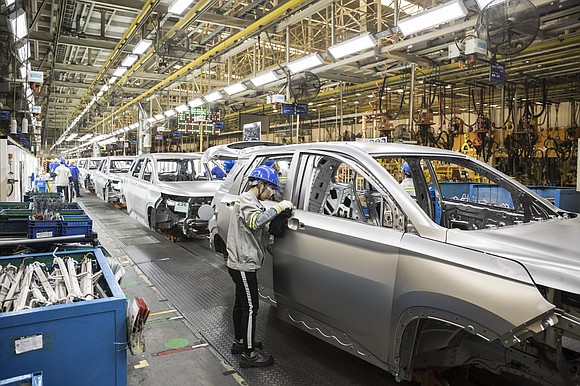GM job cuts: This is what transforming a century-old company looks like
CNN/Stylemagazine.com Newswire | 11/26/2018, 5:50 p.m.

By Matt Egan, CNN Business
(CNN) -- Mary Barra is on a mission to ensure General Motors doesn't get left behind in the evolving auto industry that it helped pioneer.
Barra knows that reinventing a century-old company is painful, but it's the only option. Otherwise, it might suffer the same fate as Sears and General Electric (GE), which failed to adapt to the disruptions ahead of them.
GM is making the difficult decisions today to prepare for a future of electric and driverless vehicles. The company announced plans on Monday to cut 15% of its salaried workforce and shut five North American facilities. The moves will save GM about $6 billion a year by 2020 -- money it can use to invest in the future.
"There is a huge disruption coming. And Mary doesn't want to be stuck on the sidelines selling the buggy whips," said Jeffrey Sonnenfeld, senior associate dean for leadership studies at the Yale School of Management. "She doesn't want to be Kodak, GE or Sears. She wants to reinvent the company."
GM is also saying goodbye to the Chevrolet Volt, Impala, Cruze and other vehicles. Instead, GM will build more of the lucrative SUVs that Americans prefer.
"GM wants to leverage high-profit SUVs and trucks as a bridge to this autonomous future," said Jeremy Acevedo, Edmunds manager of industry analysis.
'Quantum leaps'
Barra deserves credit for acting now before it's too late. Tesla (TSLA) has already proven that electric vehicles are a viable and potentially lucrative business.
By 2030, electric vehicle sales worldwide will surge to 30 million, compared with 1.1 million last year, according to Bloomberg New Energy Finance. Electrics will make up 11% of all sales in the United States by then.
"The technology is moving at quantum leaps now," Acevedo said. "It is foreseeable that even a decade down the line this industry is going to be completely different than it is today. They are adapting to survive."
In a statement, Barra said on Monday that GM recognizes "the need to stay in front of changing market conditions and customer preferences to position our company for long-term success."
Barra said it makes sense to make these moves now while the economy and business are strong.
GM under fire
But GM is already getting criticized by politicians in the United States and Canada about plans to shut down plants that employ thousands of blue-collar workers.
The restructuring will come at the expense of about 8,000 salaried workers. Another 6,000 hourly workers will either lose their jobs or be reassigned to other plants.
"I was very tough. I spoke with her when I heard they were closing, and I said, you know, this country has done a lot for General Motors," President Donald Trump told reporters on Monday.
Trump said he told Barra that she "better" reopen plants in the US and soon.
Of course, Barra is trying to reposition GM so that it can continue to be a major American force for the next century.
"She is not a teary-eyed nostalgic romantic over what GM was," said Sonnenfeld. "She's not a politician. She's in the business of telling the truth and taking care of the economic health of her company in a responsible, honest way."
Trying to avoid the fate of Sears
History is littered with companies that fell in love with the past at the expense of the future. Sears, a company that once dominated retail, filed for bankruptcy last month. Sears is just the latest brick-and-mortar store to fail in the era of Amazon (AMZN).
Eastman Kodak, another pioneer of its industry, succumbed to bankruptcy in 2012 after struggling to evolve from film to the age of digital photography. Kodak emerged from bankruptcy a year later.
General Electric is in crisis today because it kept a business model intact that no longer worked. Former GE CEO Jeff Immelt recently said he regrets failing to separate GE's industrial businesses from GE Capital, its money-losing financial arm.
Under Immelt, GE also doubled down on fossil fuels in 2015 by acquiring Alstom's power business. That deal turned out to be a disaster as coal and natural gas have been disrupted by renewable energy.
Tomorrow's GM could look more like Uber
GM is hoping to follow in the footsteps of Walmart (WMT). Unlike Sears, Walmart invested heavily in e-commerce, including its $3.3 billion acquisition of Jet.com. Today it's a leader among traditional retailers.
"What keeps Walmart in the game is everyday low prices," said William Klepper, a management professor at Columbia Business School. "But what will keep Walmart ahead of obsolescence is online. And they're just as aggressive online as anyone."
Klepper said that GM's leadership needs to be similarly "ambidextrous" by building better vehicles today but also reinventing for the future.
That future will likely look very different. GM is positioning itself to become a company that doesn't just make cars, it sells rides in autonomous vehicles.
A year ago. GM said that it could go from making about $30,000 over the lifetime of every vehicle it sells to hundreds of thousands of dollars per car if it can sell rides rather than the car itself.
That kind of dramatic shift may unfortunately cause more pain for GM employees down the line.
"As they transition to this new model for the future, there will be more tough pills to swallow along the way," said Acevedo.



